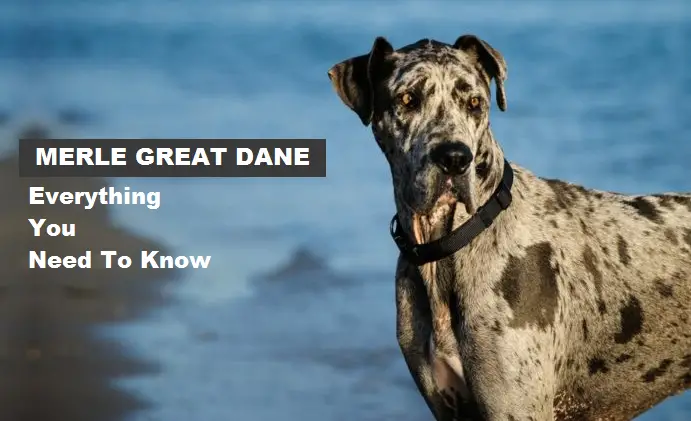Table of Contents
Have you ever stumbled upon a dog so striking that it seems to be painted by the whims of an artist’s brush? Meet the Merle Great Dane, a breed that combines grandeur with a kaleidoscope of colors. In this comprehensive guide, we’ll embark on a journey to uncover the mysteries and marvels of these enchanting canines.
What defines the Merle Great Dane breed?
The Merle Great Dane breed is defined by its distinctive coat pattern, characterized by a marbled or speckled appearance with a base color like gray, black, or white. This breed is also known for its towering size and gentle temperament.
How did the Merle coat pattern emerge?
The Merle coat pattern emerged due to a specific gene known as the Merle gene. This gene affects the distribution of pigment in the dog‘s coat, resulting in the unique patterns and colors seen in Merle Great Danes. It’s all in their genetics!
The Merle Coat Gene
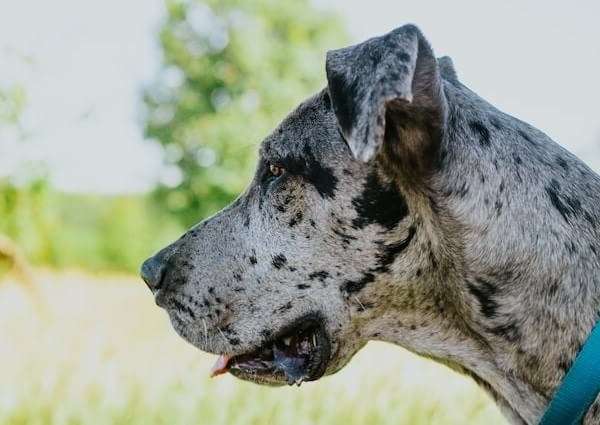
When it comes to Merle Great Danes, their striking coat patterns are all in the genes. Let’s delve into the science behind this captivating feature. Let’s dive into the genetics behind Merle Great Danes:
1. Understanding the M locus
The enchanting Merle coat pattern of Great Danes begins with the M locus in their genetic makeup. This specific locus, akin to a secret treasure chest in their DNA, is where the magic happens. It holds the key to the Merle gene, which is responsible for creating those captivating coat colors and patterns.
This gene orchestrates the distribution of pigments in their fur, resulting in the mesmerizing marbled or speckled appearance that defines Merle Great Danes. So, you could say that the M locus is like the conductor of an orchestra, orchestrating the symphony of colors in their coat.
2. Inheritance Patterns
Understanding how the Merle coat pattern is passed down through generations is like deciphering a fascinating genetic puzzle. One crucial aspect is the inheritance patterns, and it’s particularly important to note when it comes to breeding Merle Great Danes.
For instance, when two Merle Danes are bred together, it can lead to unique outcomes. Sometimes, you get a double dose of the Merle gene, resulting in what’s called a “double Merle.” While these dogs can be stunning, they may also be at a higher risk for certain health issues, including deafness and vision problems.
This is a reminder that genetics play a significant role not only in their appearance but also in their overall well-being. So, in the world of Merle Great Danes, genetics and inheritance patterns are the brushstrokes that create their remarkable coat patterns, making each one a living piece of art.
Appearance and Characteristics of Merle Great Danes
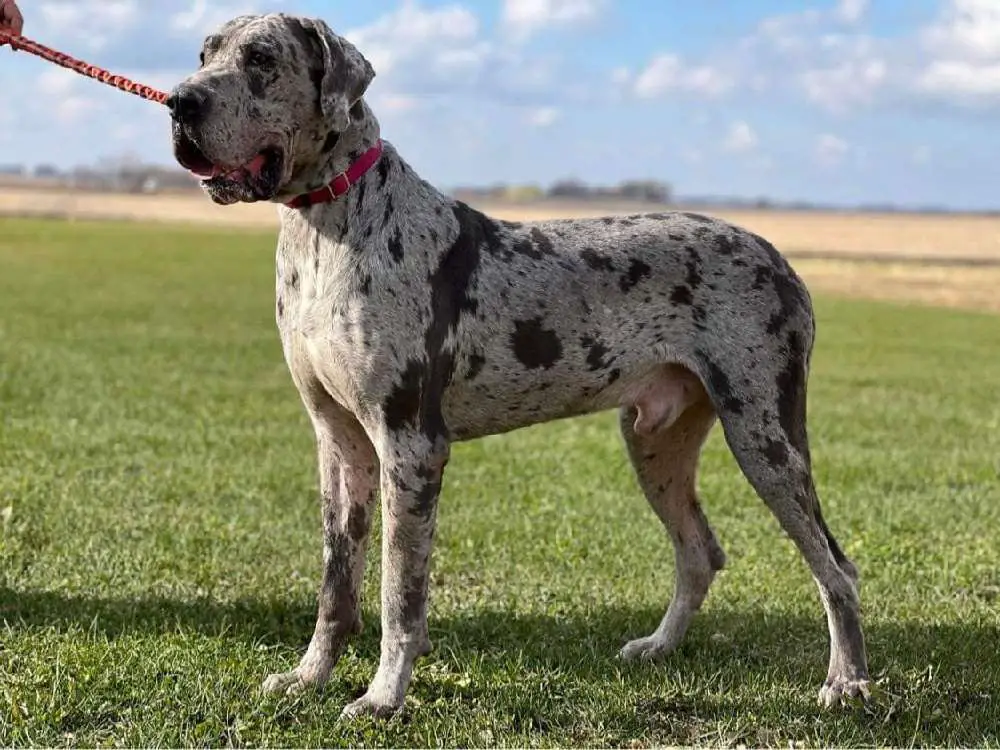
Size, Height, and Build
Male Merle Great Danes:
- Size: These magnificent canines are renowned for their immense size. On average, male Merle Great Danes typically stand between 30 to 34 inches (76 to 86 cm) at the shoulder.
- Height: When fully grown, males can weigh anywhere from 140 to 175 pounds (64 to 79 kg) or more. They are true giants of the dog world.
- Build: They have a robust and muscular build, yet their elegance and grace are undeniable. Their proportions are a balance of power and poise.
Female Merle Great Danes:
- Size: Female Merle Great Danes are slightly smaller than their male counterparts, usually ranging from 28 to 32 inches (71 to 81 cm) at the shoulder.
- Height: Their weight typically falls between 110 to 140 pounds (50 to 64 kg). While not as towering as males, they still command attention with their size.
- Build: Like the males, female Merles exhibit a well-muscled and athletic build, highlighting their grace and strength.
Common Merle Variations
Certainly, let’s explore the common variations of Merle Great Danes:
1. Blue Merle
Blue Merle Great Danes are like a tranquil day under the open sky. Their coat features a silver-gray base color, which serves as a canvas for mesmerizing dark splotches. These dark patches can vary in size and distribution, creating a unique and picturesque appearance. Blue Merles often have striking blue eyes, adding to their allure. They’re like living works of art, drawing attention wherever they go.
2. Harlequin Merle
Imagine the grandeur of ancient marble sculptures brought to life in a dog. That’s the essence of Harlequin Merle Great Danes. These majestic creatures have a predominantly white coat adorned with bold, dramatic black patches. The contrast between the white and black creates a stunning visual effect. It’s as if they were dipped in ink and emerged as living masterpieces. Harlequin Merles are known for their regal and commanding presence.
3. Black Merle
Black Merle Great Danes are reminiscent of a starry night sky. Their coat is primarily black with subtle merle markings that appear as delicate flecks or streaks of lighter color. These markings can be scattered across their body, making them resemble a celestial masterpiece. Black Merles exude an air of mystery and elegance, making them stand out even in the dark.
Eye and Nose Coloration
Eye Coloration: One of the most captivating features of Merle Great Danes is their eyes, which come in various shades. Blue Merle Danes often have striking blue eyes, while Harlequin Merles and Black Merles typically have brown eyes. Some may even have one of each, a phenomenon known as heterochromia, which adds to their unique charm.
Nose Coloration: The color of their noses can vary. It’s common to see Merle Danes with black noses, but liver-colored noses are also seen in some individuals. The nose adds another layer of intrigue to their appearance.
Unique Markings and Patterns
The hallmark of Merle Great Danes is their mesmerizing coat patterns. These can vary widely, even among dogs of the same variation. Some common patterns and markings include:
- Marbling: Irregular splotches and swirls of color, creating a marble-like effect.
- Speckling: Tiny flecks of lighter color scattered across the darker base coat.
- Patches: Distinctive patches or spots of a different color, creating a striking contrast.
- Blotches: Larger, irregular-shaped markings that can cover a significant portion of the body.
Each Merle Dane boasts a one-of-a-kind combination of these patterns and markings, making them as unique as a fingerprint. It’s these variations that turn them into living works of art and capture the hearts of dog enthusiasts worldwide.
Let’s delve into the temperament and personality of Merle Great Danes:
Temperament and Personality
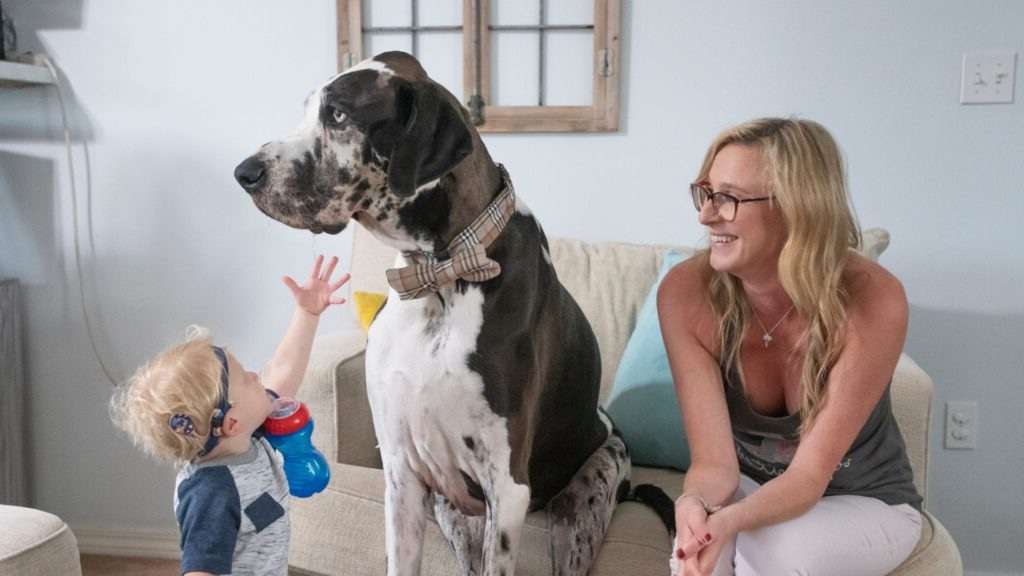
Typical Great Dane Traits
Merle Great Danes are known for their larger-than-life personalities, and many of their characteristics are shared with the broader Great Dane breed.
- Gentle Giants: They may be massive, but their hearts are equally colossal. Merle Great Danes are gentle giants known for their affectionate and loving nature.
- Friendly and Sociable: These dogs are typically friendly and sociable, making them excellent companions for families and individuals alike.
- Loyal: Loyalty is a defining trait. Merle Great Danes often form strong bonds with their owners and can be protective when needed.
- Good with Children: Despite their size, they tend to be patient and gentle with children, earning them the nickname “gentle giants.”
Influence of Coat Color on Temperament
One common myth surrounding Merle Great Danes is that their coat color influences their temperament. However, it’s essential to debunk this notion. Coat color does not determine a dog’s personality. Instead, temperament is primarily shaped by genetics, upbringing, and socialization.
- Individual Variability: Just like humans, dogs have unique personalities. While coat color may catch the eye, it doesn’t dictate their behavior.
- Socialization Matters: Early socialization plays a crucial role in shaping a Merle Dane’s temperament. Proper exposure to various people, animals, and experiences can help ensure a well-rounded and confident dog.
- Training: Consistent training and positive reinforcement are key factors in molding a Merle Great Dane’s behavior, regardless of their coat color.
Socialization and Training Tips
When it comes to raising a well-adjusted Merle Great Dane, socialization and training are essential:
Socialization
Let’s break down these important aspects of socialization:
Early Exposure: Early exposure involves introducing your Merle Great Dane puppy to various people, animals, and environments at a young age. This helps them become well-adjusted, confident adults. Here’s how it works:
- Critical Period: The critical socialization period for puppies is typically between 3 and 14 weeks of age. During this time, they are more receptive to new experiences and less likely to be fearful.
- Positive Introductions: Expose your puppy to different people, including children, adults, and strangers. Also, introduce them to other animals, such as dogs, cats, and even smaller pets.
- Environments: Take your puppy to different places like parks, streets, pet stores, and even busy areas with controlled exposure to cars and noise.
- Positive Associations: Ensure that these early encounters are positive. Use treats, praise, and toys to create positive associations with new experiences.
Positive Experiences: Creating positive experiences is crucial to building your Merle Great Dane’s confidence and reducing anxiety. Here’s how to do it:
- Gentle and Gradual: Introduce new experiences gradually. If your puppy is unsure or anxious, don’t force them into situations. Let them explore at their own pace.
- Reward and Praise: Whenever your puppy behaves well during a new experience, reward them with treats and praise. This reinforces the idea that new things are positive.
- Play and Interaction: Encourage positive interactions with other dogs and people. Arrange playdates with well-socialized dogs and supervise these interactions to ensure safety.
- Variety: Expose your puppy to a variety of stimuli, including different surfaces, sounds, and objects. This helps them become adaptable and less prone to fear.
Consistency: Consistency is the key to effective socialization and ensuring your Merle Great Dane grows into a well-rounded adult dog:
- Daily Effort: Make socialization a daily effort. Even short sessions can be effective. Consistency is more important than the duration of exposure.
- Everyone on Board: Ensure that everyone in your household follows the same socialization plan and uses the same commands and rewards. Consistency at home is just as crucial as outside experiences.
- Positive Reinforcement Continues: Continue using positive reinforcement techniques during socialization to maintain a positive association with new experiences.
- Lifelong Process: Socialization doesn’t end when your Merle Great Dane reaches adulthood. Continue exposing them to new situations throughout their life to prevent regression.
By focusing on early exposure, creating positive experiences, and maintaining consistency, you’ll help your Merle Great Dane become a confident, well-socialized, and happy companion.
Training
Certainly, let’s break down each of these aspects for Merle Great Dane care:
Positive Reinforcement:
- Treats and Praise: When your Merle Great Dane exhibits good behavior, reward them with treats and plenty of verbal praise. Positive reinforcement goes a long way in reinforcing desired actions.
- Playtime as a Reward: Dogs, including Merle Danes, thrive on play. Use play sessions as rewards for following commands or displaying proper behavior. This not only reinforces good behavior but also strengthens your bond.
- Clicker Training: Consider using a clicker as a sound cue to signal when your dog has done something correctly. Pair the click with a treat or affection to create a positive association with the clicker.
- Consistency: Be consistent in your rewards. Make sure everyone in your household follows the same rules and uses the same commands and rewards. Consistency helps your dog understand what is expected.
- Patience and Timing: Be patient and reward your dog immediately after they perform the desired action. Timing is crucial, as it helps your Dane associate the reward with their behavior.
Obedience Training:
- Basic Commands: Start with fundamental commands like “sit,” “stay,” “come,” and “heel.” These commands provide the foundation for good behavior and safety.
- Positive Reinforcement: Use positive reinforcement techniques to teach obedience. Reward your Dane when they obey commands correctly.
- Consistent Practice: Practice obedience commands regularly. Short, frequent training sessions are more effective than long, infrequent ones.
- Professional Training: If you’re new to dog training or face challenges with obedience, consider enrolling your Merle Great Dane in a professional training class. A professional trainer can provide guidance and help address specific issues.
- Be Firm but Gentle: Maintain a firm but gentle approach to training. Great Danes are sensitive dogs, so using force or harsh punishment can be counterproductive.
Exercise:
- Daily Exercise: Merle Great Danes are active dogs despite their size. They require daily exercise to stay healthy and happy. Aim for at least 30 to 60 minutes of physical activity, which can include walks, playtime, or off-leash running in a secure area.
- Mental Stimulation: In addition to physical exercise, engage their minds with puzzle toys, interactive games, and obedience training. Mental stimulation is as important as physical activity.
- Structured Exercise: While they enjoy playtime, keep it structured. Playing fetch or going for structured walks with loose-leash training can help them burn off energy and maintain good behavior.
- Watch for Signs of Fatigue: Be mindful of your dog’s energy levels. Don’t overexert them, especially in hot weather, as Merle Danes can be sensitive to heat.
- Variety: Mix up their exercise routine to prevent boredom. Exploring new environments or trying different activities can keep them mentally engaged and physically fit.
By understanding their typical traits, debunking myths related to coat color, and prioritizing socialization and training, you can raise a well-behaved and happy Merle Great Dane that’s a true joy to be around.
Merle Great Dane Care and Maintenance
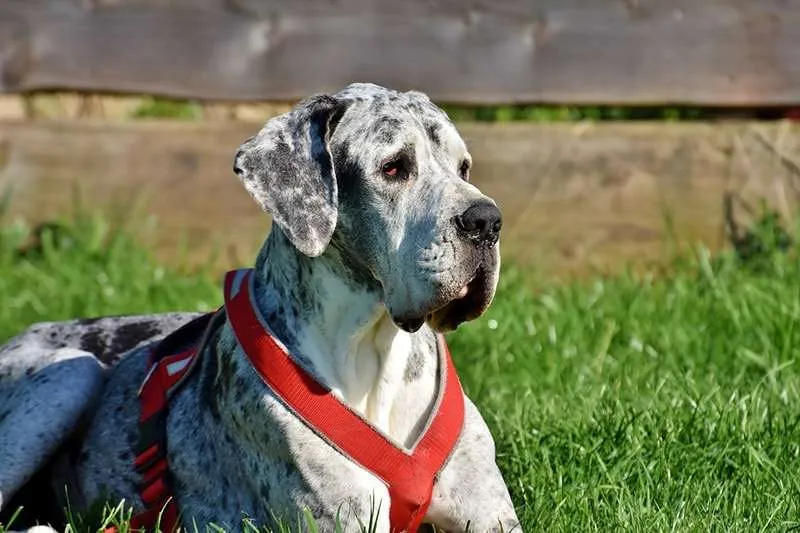
Diet and Nutrition
Diet and nutrition are critical for the health and well-being of your Merle Great Dane. Here’s a table outlining their dietary needs:
| Dietary Aspect | Description |
|---|---|
| High-Quality Food | Opt for premium dog food with real meat as the primary ingredient. Avoid fillers like corn and wheat. |
| Protein Content | Ensure the food contains a suitable protein level, around 20-25%, to support their muscle mass. |
| Large-Breed Formula | Choose food specifically formulated for large breeds to support healthy growth and joint health. |
| Feeding Schedule | Divide their daily food into two or three meals to prevent bloat, a common concern in large breeds. |
| Monitor Weight | Keep an eye on their weight to prevent obesity, which can lead to various health issues. Adjust portions as needed. |
| Fresh Water | Provide access to clean, fresh water at all times to keep them hydrated. |
Exercise Requirements
Merle Great Danes may be giants, but they need regular exercise to stay healthy and happy. Here’s a breakdown of their exercise needs:
- Daily Exercise: Aim for at least 30-60 minutes of physical activity every day. This can include brisk walks, playtime, and off-leash running in a secure area.
- Mental Stimulation: Engage their minds with puzzle toys, obedience training, and interactive games. Mental stimulation is just as important as physical exercise.
- Structured Exercise: When exercising, keep it structured. Playing fetch or going for structured walks with loose-leash training can help them burn off energy and maintain good behavior.
- Watch for Signs of Fatigue: Be attentive to your dog’s energy levels, especially in hot weather. Danes are sensitive to heat, so avoid overexertion.
Grooming Tips for Merle Danes
Maintaining your Merle Great Dane’s coat and overall hygiene is essential for their well-being. Here are five grooming tips:
- Regular Brushing: Brush their coat regularly to remove loose hair and prevent matting. Use a soft-bristle brush or a grooming mitt to keep their coat shiny and healthy.
- Bath as Needed: Bathe your Dane when they become dirty or develop an odor. Use a dog-specific shampoo, and be sure to rinse thoroughly.
- Nail Care: Keep their nails trimmed to a comfortable length. Overgrown nails can cause discomfort and affect their gait.
- Ear Cleaning: Clean their ears regularly to prevent infections. Use a gentle, dog-friendly ear cleaner and avoid inserting anything deep into the ear canal.
- Dental Care: Dental hygiene is vital. Brush their teeth regularly and provide dental chews or toys to reduce tartar buildup.
Health Considerations
1. Regular Vet Check-ups
Regular veterinary check-ups are crucial to monitor your Merle Great Dane’s overall health, detect issues early, and ensure they receive appropriate vaccinations and preventive care.
2. Merle-specific Health Concerns
Deafness: Merle Great Danes may be more prone to deafness due to the Merle gene’s effects on the inner ear. Regular hearing assessments are essential.
Ocular Issues: Those captivating blue eyes can be more sensitive to light. Protect their eyes from excessive sun exposure to prevent eye problems.
Sun Sensitivity: The lighter patches on their coat can make them prone to sunburn. Consider using pet-safe sunscreen on exposed areas during sunny days.
Common Health Issues in Great Danes
Here’s a table outlining five common health issues in Great Danes, their symptoms, and possible remedies:
| Health Issue | Symptoms | Remedies |
|---|---|---|
| Bloat (Gastric Torsion) | Swollen abdomen, restlessness, drooling, unproductive vomiting | Immediate veterinary attention; surgery may be required. |
| Hip Dysplasia | Lameness, difficulty getting up or climbing stairs | Weight management, physical therapy, and joint supplements. |
| Dilated Cardiomyopathy | Coughing, difficulty breathing, lethargy | Medications to manage symptoms and slow progression. |
| Osteosarcoma (Bone Cancer) | Lameness, swelling, pain, and reluctance to move | Treatment may involve amputation, chemotherapy, or radiation therapy. |
| Hypothyroidism | Weight gain, lethargy, skin issues, hair loss | Hormone replacement therapy prescribed by a veterinarian. |
Regular vet check-ups and early detection can help manage these health concerns effectively. Always consult your veterinarian for guidance specific to your Merle Great Dane’s health and well-being.
Living with a Merle Great Dane
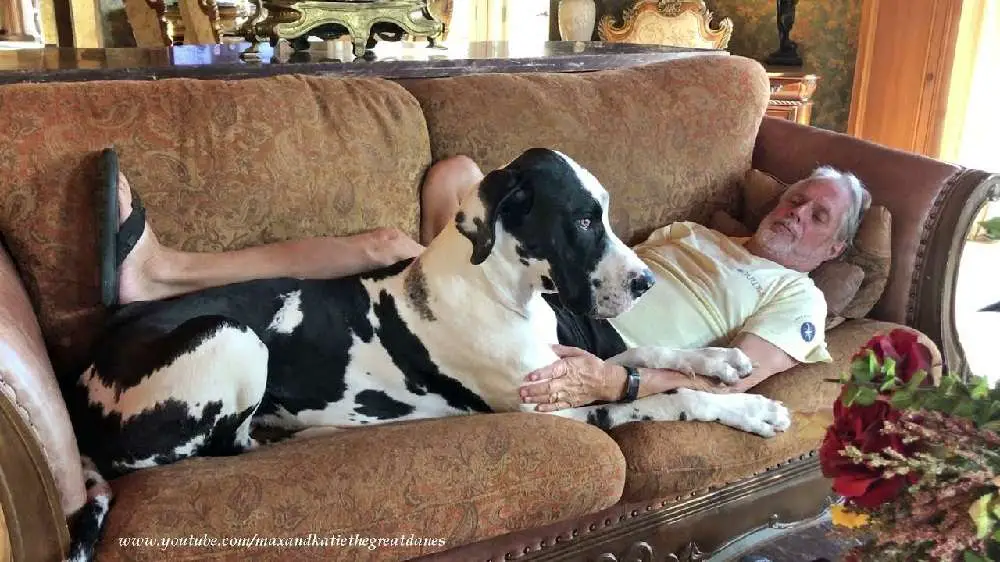
Ideal Living Arrangements
Merle Great Danes are big dogs with big hearts, but they have specific living needs:
- Space: They need ample space to move around comfortably. While they can adapt to apartment living with enough exercise, a spacious home or a house with a yard is ideal.
- Climate: They are sensitive to extreme heat and cold, so provide climate control to keep them comfortable.
- Secure Fencing: If you have a yard, ensure it has secure fencing. Great Danes can be curious, and a well-fenced yard helps keep them safe.
Interaction with Other Pets
Merle Great Danes are generally good with other pets, but proper introductions are crucial:
- Other Dogs: They usually get along well with other dogs, especially if they are socialized from a young age. Supervised playdates can be beneficial.
- Cats and Smaller Pets: With proper socialization, they can coexist with cats and smaller pets, but supervision is essential, especially initially.
Children and Family Compatibility
Merle Great Danes are known for their gentle nature, making them compatible with families:
- Children: They are usually excellent with children and can be very gentle. However, their size should be taken into consideration. Teach children how to interact respectfully with the dog.
- Family Dogs: They thrive in a family setting and often form strong bonds with all family members. They enjoy being part of the family activities.
Potential Challenges and Solutions
Here’s a table outlining potential challenges when living with a Merle Great Dane and some solutions:
| Challenge | Solution |
|---|---|
| Size and Space | Ensure you have enough space and secure fencing for their needs. |
| Exercise Requirements | Commit to regular exercise and mental stimulation. |
| Gentle Training | Use positive reinforcement methods for training and behavior. |
| Health Costs | Be prepared for potential veterinary expenses due to their size. |
| Socialization and Training | Invest time in socialization and obedience training from puppyhood. |
Living with a Merle Great Dane can be incredibly rewarding, but it’s essential to understand their specific needs and challenges to provide them with a happy and healthy life as a cherished member of your family.
Let’s explore the critical aspects of responsible ownership and breeding of Merle Great Danes:
THE GREAT DANE – THE TALLEST DOG IN THE WORLD
Breeding and Responsible Ownership
Ethical Breeding Practices
1. Avoiding Merle-to-Merle Breeding:
Breeding Merle Great Danes requires careful consideration to ensure the health and well-being of the puppies. Avoid Merle-to-Merle breeding to prevent potential health issues associated with double Merle genes, which can lead to deafness and vision problems.
2. Genetic Testing:
Responsible breeders conduct genetic testing to screen for potential hereditary health issues in Merle Great Danes. This includes testing for conditions like hip dysplasia, cardiac problems, and eye diseases. Ensuring that both the sire and dam are genetically healthy is essential to produce healthy litters.
Finding a Reputable Breeder
When considering a Merle Great Dane, it’s crucial to find a reputable breeder who prioritizes the health and well-being of the dogs:
- Research: Do thorough research to find breeders with a strong reputation for ethical breeding practices. Look for breed clubs and organizations that endorse responsible breeders.
- Visit the Breeder: Visit the breeder in person to see the living conditions of the dogs and ask questions about their breeding practices.
- Health Certifications: Ensure that the breeder provides health certifications for both the parents and puppies. These should include genetic testing results and vaccination records.
- References: Ask for references from previous buyers to get insights into their experience with the breeder.
Adoption and Rescue Options
Adoption and rescue are noble options for providing a loving home to a Merle Great Dane:
- Rescue Organizations: Look for Great Dane rescue organizations that specialize in rehoming and rehabilitating Danes in need of homes.
- Shelters: Local animal shelters may have Merle Great Danes available for adoption. Adopting from a shelter can be a rewarding experience.
- Foster Programs: Consider participating in foster programs that provide temporary care for Merle Great Danes until they find permanent homes.
Remember that adopting or rescuing a Merle Great Dane can be a wonderful way to provide a loving home to a dog in need while also contributing to responsible ownership within the breed.
Let’s address the myths and misconceptions surrounding Merle Great Danes and provide additional resources for interested individuals:
Merle Great Dane Myths and Misconceptions
Debunking Common Misbeliefs
It’s essential to debunk the myths surrounding Merle Great Danes to provide accurate information:
- Myth 1: Merle Great Danes are a Separate Breed: Merle is a coat pattern, not a separate breed. Merle Great Danes are still Great Danes.
- Myth 2: All Merles are Deaf or Blind: While double Merles may have a higher risk of deafness or vision problems, not all Merles are affected. Responsible breeding can mitigate these issues.
- Myth 3: Merles are More Aggressive: Coat color does not dictate a dog’s temperament. Merle Great Danes are known for their gentle and friendly nature.
- Myth 4: Merles are Less Healthy: Health depends on breeding and genetics, not coat color. Responsible breeders prioritize the health of their dogs.
Addressing Stereotypes and Prejudices
- Stereotype 1: Merle Danes are Show Dogs Only: Merle Great Danes can be loving family pets, not just show dogs.
- Stereotype 2: Merles are Harder to Train: Training success depends on methods and consistency, not coat color.
- Prejudice 1: Negative Stereotyping of Merle Breeders: Not all Merle breeders are irresponsible; many prioritize the health of their dogs.
- Prejudice 2: Misconceptions about Merle Adoption: Merle Great Danes available for adoption can be wonderful companions.
The Importance of Education
- Education: Promote education about responsible breeding, genetics, and the unique needs of Merle Great Danes.
- Breed Standards: Encourage understanding of breed standards and responsible ownership within the Great Dane community.
- Support: Provide support and resources for those interested in Merle Great Danes to make informed decisions.
Conclusion
As we conclude our journey through the world of Merle Great Danes, remember that these magnificent dogs are not just pets; they’re living canvases of beauty and love. Whether you’re a seasoned dog owner or a first-time enthusiast, the allure of the Merle Great Dane is bound to capture your heart. So, are you ready to embark on this colorful adventure? Your next loyal and artistic companion might just be a Merle Great Dane away.
Additional Resources
Books and Publications
- “The Great Dane: Gentle Giant” by Kathleen T. Buxton
- “Great Danes” by Joe Stahlkuppe
- “The Merle Danes and Beyond” by Raisa Yalovetski
Websites and Online Communities
- The Great Dane Club of America: A valuable resource for Great Dane enthusiasts with information on breed standards, health, and events.
- Merle Great Dane Club: A community dedicated to Merle Great Danes, offering insights and guidance.
Breed Clubs and Associations
- The American Kennel Club (AKC) – Great Dane: Information about the Great Dane breed, breed standards, and responsible ownership.
- The Great Dane Club of America: A national club focused on promoting and preserving the breed.
These resources provide a wealth of information and support for individuals interested in Merle Great Danes, whether they are considering ownership, seeking responsible breeders, or looking to learn more about this unique and beloved breed.
FAQs related to Merle Great Danes
- Q: Can Merle Great Danes participate in dog sports and agility competitions?
- A: Yes, absolutely! Despite their size, Merle Great Danes can excel in various dog sports, including agility, obedience, and even canine sports like dock diving. Their athleticism and intelligence make them versatile competitors.
- Q: Are there any famous Merle Great Danes in popular culture?
- A: Yes, a few Merle Great Danes have gained recognition in popular culture. For instance, “Scooby-Doo,” the iconic cartoon character, is often thought to be a Great Dane with a Merle-like coat pattern.
- Q: Do Merle Great Danes require specialized grooming due to their unique coat patterns?
- A: While their coats are stunning, they don’t typically require specialized grooming. Regular brushing, bathing as needed, and basic grooming practices are sufficient to keep their coats healthy and beautiful.
- Q: Are Merle Great Danes prone to certain dietary sensitivities or allergies?
- A: Like any dog breed, individual sensitivities can vary, but there’s no specific dietary concern linked to their Merle coat pattern. It’s essential to choose high-quality dog food appropriate for large breeds and monitor for any signs of food sensitivities.
- Q: Can Merle Great Danes participate in therapy dog programs or assistance work?
- A: Yes, they can make wonderful therapy dogs and provide valuable emotional support. Their gentle nature and size make them well-suited for therapy and assistance work, where they can bring comfort and joy to those in need.

